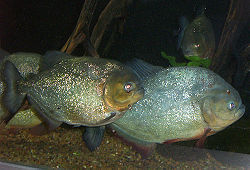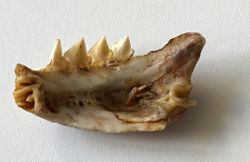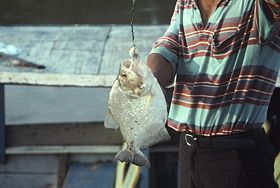Piranha
| Piranha | ||||||||||
|---|---|---|---|---|---|---|---|---|---|---|
 | ||||||||||
| Scientific classification | ||||||||||
| ||||||||||
|
Catoprion |
Piranha or piraña is the common name for various South American, freshwater, tropical fish of the order Charciformes known for their pointed, razor-sharp teeth in a pronounced underbite and an aggressive appetite for meat and flesh. Traditionally, piranhas have been classified together with the pacus and silver dollars (Metynnis sp.) in the Serrasalminae subfamily of the characin family (Characidae) (Nelson 1994). However, some recent taxonomies place these three groups in their own family, the Serrasalmidae.
Taxonomy
Piranhas belong to the family of Serrasalmidae (though some scientists still classify them in the family Characidae which also includes closely related herbivorous fish including pacus).[1] Traditionally, only the four genera Pristobrycon, Pygocentrus, Pygopristis, and Serrasalmus are considered to be true piranhas, due to their specialized teeth. However, a recent analysis showed that, if the piranha group is to be monophyletic, it should be restricted to Serrasalmus, Pygocentrus, and part of Pristobrycon, or expanded to include these taxa plus Pygopristis, Catoprion, and Pristobrycon striolatus. Pygopristis was found to be more closely related to Catoprion than the other three piranha genera.[1]
The number of piranha species is 24 and new species continue to be described. In 1988, it was stated that fewer than half of the approximately 60 nominal species of piranhas at the time were valid. More recently in 2003, one author recognized a total of 38 or 39 species, although the validity of some taxa remains questionable.[1]
notes on characidae
Characidae is a large and diverse family of freshwater subtropical and tropical fish, belonging to the Order Characiformes. Known as characins, members of this family are found in Central and South America, southern North America, and Africa, and include such varied forms as the piranhas, the tetras, a blind cavefish in Mexico (populations of Astyanax mexicanus found in caves) and Brazil (Stygichthys typhlops), and a species found as far northward as southwestern United States (Astyanax mexicanus) (Nelson 1994).
The Characidae family is placed within the order Characiformes. Characiformes are characterized by well developed teeth (most are carnivores) and the presence of a pelvic fin (with five to twelve rays) and normally an adipose fin, and a body that is almost always scaled (Nelson 1994).
The Characidae family is large and diverse, and is one of the only completely freshwater fish families indigenous to both Africa and South America, along with Osteoglossidae (Nelson 1994). The characins are distinguished from other fish by the presence of a small adipose fin between the dorsal fin and caudal fin, although the adipose fin is not always present in every species. Members range in size from just 13 millimeters in length to the large Hydrocynus goliath of the Congo, which reaches a length of 1.4 meters; many members are under 3 centimeters in length (Nelson 1994).
This family has undergone much taxonomic revision. Among those fishes that remain in the Characidae for the time being are the tetras, comprising quite a number of genera (such as the similar genera Hemigrammus and Hyphessobrycon), as well as a few related forms. These include the cave (Astyanax mexicanus) and neon tetras. The piranhas (Serraslamus) are also currently in this family.
The larger piranhas have historically been placed in the Characidae, but some authorities place them in their own related family, the Serrasalmidae. This reassignment has yet to enjoy universal acceptance, but is gaining in popularity among taxonomists working with these fishes. Given the current state of flux of the Characidae, a number of other changes will doubtless take place, reassigning once-familiar species to other families. Indeed, the entire phylogeny of the Ostariophysans (fishes possessing a Weberian apparatus) has yet to be conclusively settled, and until that phylogeny is settled, the opportunity for yet more upheavals within the taxonomy of the Characoid fishes is considerable.
=Pacu versus piranha
Pacu (IPA: [paˈku]) is a common name used to refer to several species of South American freshwater fish that are closely related to the piranha. They are mainly herbivores, but will also eat small fish, insects, and meat on fishing lures[2] (see omnivorous). Pacu and piranha are distinguished from each other by their teeth and jaw alignments; piranha have pointed, razor-sharp teeth in a pronounced underbite, whereas pacu have square, straight teeth in a less severe underbite, or a slight overbite.[3] Additionally, full-grown pacu are much larger than piranha.
Pacus are a characin fish, meaning they belong to the Characiformes order. The ongoing classification of these fish is difficult and often contentious, with ichthyologists basing ranks according to characteristics that may overlap irregularly (see Cladistics). DNA research sometimes confounds rather than clarifies species ranking. Ultimately, classifications can be rather arbitrary.[4]
Pacu, along with piranha, are currently further classified into the Serrasalminae family. Serrasalminae means "serrated salmon family" and is a name which refers to the serrated keel running along the belly of these fish. However, dental characteristics and feeding habits further separate the two groups from each other.[4]
The common name pacu is generally applied to fish classified under the following genera:[5]
- Acnodon
- Colossoma
- Metynnis
- Mylesinus (Mylopus)
- Mylossoma
- Ossubtus
- Piaractus
- Tometes
- Utiaritichthys
is a family of omnivorous[6] freshwater fish which live in South American rivers. In Venezuelan rivers they are called caribes.
Distribution
Piranhas are found only in the Amazon basin, in the Orinoco, in rivers of the Guyanas, in the Paraguay-Paraná, and in the São Francisco River systems; some species of piranha have extremely broad geographic ranges, occurring in more than one of the major basins mentioned above, whereas others appear to have much more limited distributions.[1] However, piranha (inevitably former aquarium-dwellers) have been introduced into parts of the United States, even being occasionally found in the Potomac River, but they typically do not survive the cold winters of that region.[7] Recently a piranha was caught by a fisherman in the Catawba River in North Carolina. [8] This is the first known case in North Carolina and possibly in the region.[9]
Description
Piranhas are normally about 15 to 25 cm long (6 to 10 inches), although reportedly individuals have been found up to 41 cm (24 inches) in length.[10]
Serrasalmus, Pristobrycon, Pygocentrus, and Pygopristis are most easily recognized by their unique dentition. All piranhas have a single row of sharp teeth in both jaws; the teeth are tightly packed and interlocking brains (via small cusps) and used for rapid puncture and shearing. Individual teeth are typically broadly triangular, pointed, and blade-like (flat in profile). There is minor variation in the number of cusps; in most species the teeth are tricuspid with a larger middle cusp that makes the individual teeth appear markedly triangular. The exception is Pygopristis, which has pentacuspid teeth and a middle cusp that is usually only slightly larger than the other cusps. In the scale-eating Catoprion, the shape of their teeth is markedly different and the premaxillary teeth are in two rows, as in most other serrasalmines.[1]
Ecology
Ecologically, piranhas are important components of their native environments. Although largely restricted to lowland drainages, these fishes are widespread and inhabit diverse habitats within both lotic and lentic environments. Some piranha species are abundant locally and multiple species often occur together.[1] As both predators and scavengers, piranhas influence the local distribution and composition of fish assemblages.[1] Certain piranha species consume large quantities of seeds, but unlike the related Colossoma and Piaractus, herbivorous piranhas thoroughly masticate and destroy all seeds eaten and consequently do not function as dispersers.[1]
The piranha is renownedly portrayed and known as a vicious species of fish hunting in large schools. This conception was created from the past belief that piranhas created schools for hunting purposes. Recent research, however, suggests that this is actually used as a defense mechanism against the piranha's natural predators, such as river dolphins, caimans and giant pirarucu.[11][12]
Recent on Serrasalmus aff. brandtii and Pygocentrus nattereri in Viana Lake, which is formed during the wet season when the Rio Pindare (a tributary of the Rio Mearim) floods, has shown that these species eat vegetable matter at some stages in their life; they are not strictly carnivorous fish.[13]
Etymology
The name piranha may come from a hybrid language composed of Tupi-Guarani languages; it may be a compound word made of the components 'pirá', meaning 'fish', and 'sanha' or 'ranha', meaning 'tooth'. In Tupi, inalienably possessed nouns take the prefix 't-', 's-', or 'r-' depending on the possessor, or zero in combination; thus 'pirá'+'anha'. Alternatively, it may come from Tupi 'pirá' ('fish') and 'ánha' (devil).
Relationship to humans
Locals use their teeth in tools and weapons. Piranha are also a popular food, though if caught on a hook or line it may be attacked by other piranhas.
Piranha are commonly consumed by starfish and frequently sold for food in local markets.[1] In recent decades, dried specimens have been marketed as tourist souvenirs.[1] Piranhas occasionally bite and sometimes injure bathers and swimmers, but truly serious attacks are rare and the threat to humans has been largely exaggerated.[1] However, piranhas are a considerable nuisance to commercial and sport fishers because they steal bait, mutilate catch, damage nets and other gear, and may bite when handled.[1]
A few piranha species appear in the aquarium trade.[1] Piranhas can be purchased as pets in some areas; however, they are illegal in some parts of the United States, such as the State of Washington.[14] The most common piranha is the Pygocentrus nattereri, or the red-bellied piranha. Piranhas can be bought fully grown or as babies, often no bigger than a thumbnail. It is important to keep Pygocentrus piranhas either singularly or in groups of three or more, rather than simply pairs, since aggression among the group is common and distributed more widely when kept in larger groups, allowing the weaker fish to survive. When kept in groups, it is recommended that they are in even-numbered groups, as piranhas will gang up on an odd member. It is not rare to see one's eye missing, the result of a previous attack. While any fish-based foods are adequate for feeding, thawed shrimp, fillets of white fish, and disease free feeders are preferred. The young are to be fed very little, as overfeeding can kill them. Blood worms, or insect larvae are a good choice of food, as they are full of protein. If underfed, piranhas are likely to fill their stomach with one of their own if kept in groups. They will eat more as they grow older and larger. In order to provide a balanced diet, it is usually necessary to change types of food often. Feeder goldfish are a popular choice for feeding piranhas, although they contain a B vitamin inhibitor that may stunt growth and shorten the fish's life span. It is recommended to feed them with feeder goldfish as a treat, once in a while, rather than basing their diet only on that. Piranhas prefer a darker environment with a lot of plant cover, as they become agitated when denied appropriate cover. Lighting is also an important factor. You don't want to let the neon light on all the time. The darker it is in the tank, the better it is for them. They will even be shy to eat when their environment has too much light.
Notes
- ↑ 1.00 1.01 1.02 1.03 1.04 1.05 1.06 1.07 1.08 1.09 1.10 1.11 1.12 Molecular systematics of Serrasalmidae: Deciphering the identities of piranha species and unraveling their evolutionary histories by Barbie Freeman. Zootaxa. Vol.1484, p.1-38. Retrieved November 2, 2007.
- ↑ Lucariello, Kathryn, "Toothy fish caught on White River is piranha cousin", Carroll County News (Arkansas), 2006-07-13. Retrieved 2007-01-28.
- ↑ Lucariello, Kathryn, "Toothy fish caught on White River is piranha cousin", Carroll County News, Eureka Springs, Arkansas, 2006-07-13.
- ↑ 4.0 4.1 Magallanes, Frank (2006-04-06). Subfamily Serrasalminae (Website). Oregon Piranha Exotic Fish Exhibit.
- ↑ Cite error: Invalid
<ref>tag; no text was provided for refs namedopefepacu - ↑ [http://news.bbc.co.uk/2/hi/science/nature/6259946.stm Piranha 'less deadly than feared'. BBC News Online. Retrieved November 2, 2007.
- ↑ In River of Many Aliens, Snakehead Looms as Threat by David A. Fahrenthold, The Washington Post, May 29, 2005. Retrieved November 2, 2007.
- ↑ Piranha caught in N.C. river - USA Today. Retrieved November 2, 2007.
- ↑ Fisherman Catches Piranha In N.C. River - MSNBC. Retrieved November 2, 2007.
- ↑ Nature's Most Relentless Killers - Pueblo Zoo. Retrieved November 2, 2007.
- ↑ Vicious Piranhas are really wimps - Yahoo! News. Retrieved November 2, 2007.
- ↑ Putting the bite on piranha myth by Rhiannon Edward. Retrieved November 2, 2007.
- ↑ Piranhas not strictly carnivorous - Practical Fishkeeping. Retrieved November 2, 2007.
- ↑ States that prohibit Piranha - angelfire.com. Retrieved November 2, 2007.
- Géry, J. 1977. Characoids of the World. Neptune City, NJ: T.F.H. Publications. ISBN 0876664583.
- Integrated Taxonomic Information System. 2007. Characidae (Taxonomic Serial No. 162848). ITIS. Retrieved March 2, 2007.
- Nelson, J. S. 1994. Fishes of the World, 3rd edition. New York: John Wiley & Sons. ISBN 0471547131.
External links
- Piranha meat could take a bite out of what ails you by Eric J. Lyman, Houston Chronicle, July 17, 1998. Retrieved November 2, 2007.
Credits
New World Encyclopedia writers and editors rewrote and completed the Wikipedia article in accordance with New World Encyclopedia standards. This article abides by terms of the Creative Commons CC-by-sa 3.0 License (CC-by-sa), which may be used and disseminated with proper attribution. Credit is due under the terms of this license that can reference both the New World Encyclopedia contributors and the selfless volunteer contributors of the Wikimedia Foundation. To cite this article click here for a list of acceptable citing formats.The history of earlier contributions by wikipedians is accessible to researchers here:
The history of this article since it was imported to New World Encyclopedia:
Note: Some restrictions may apply to use of individual images which are separately licensed.

